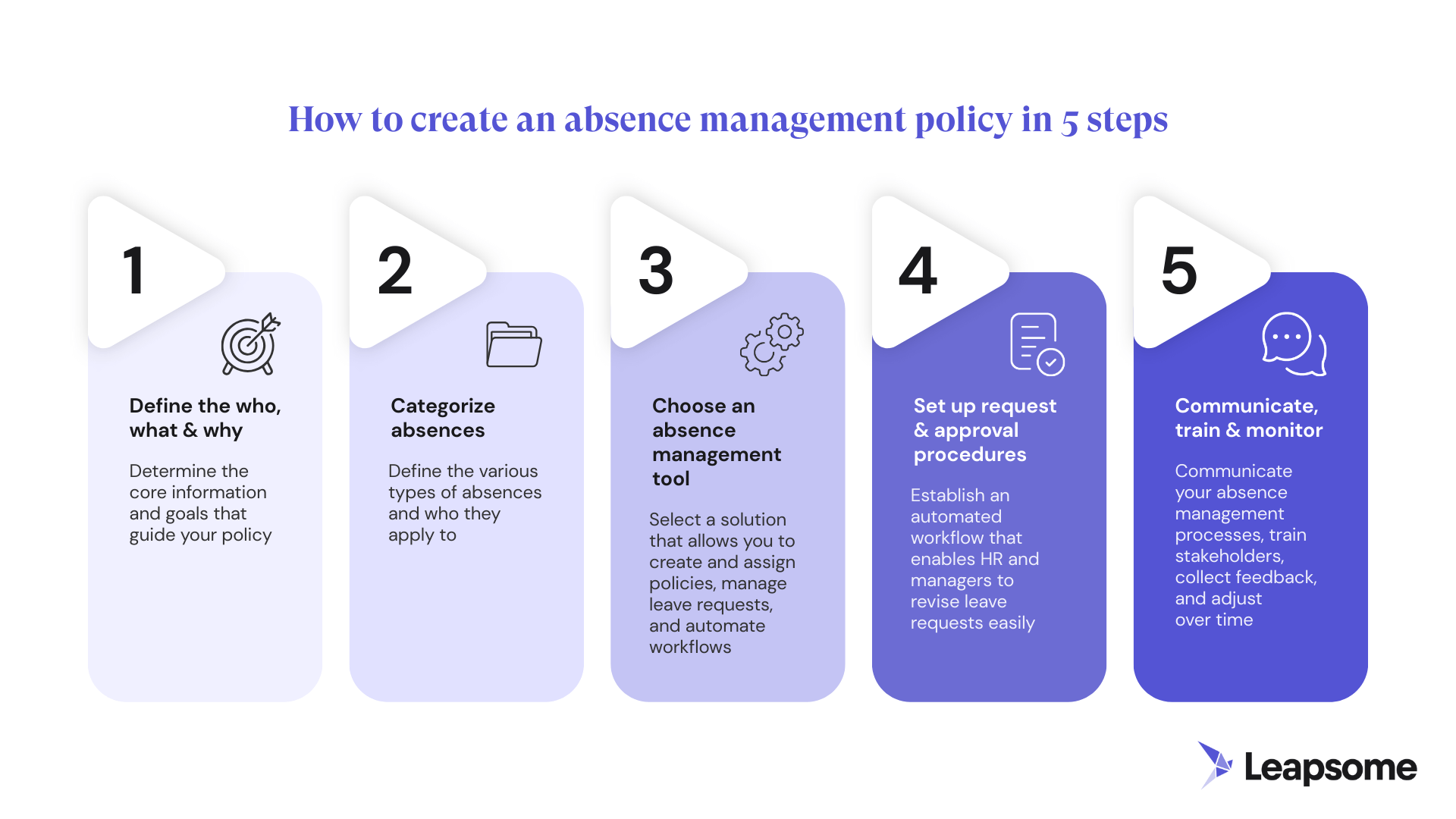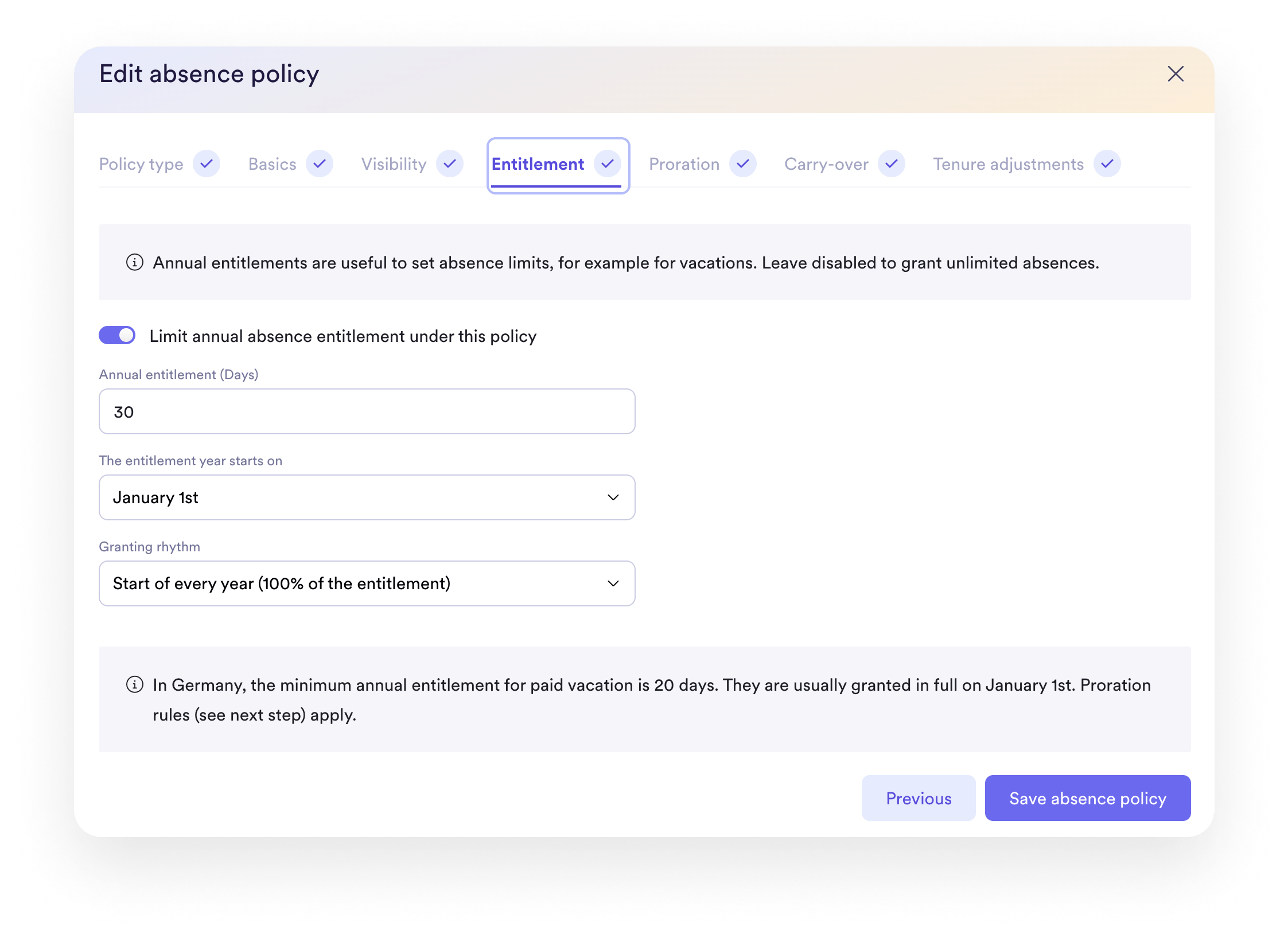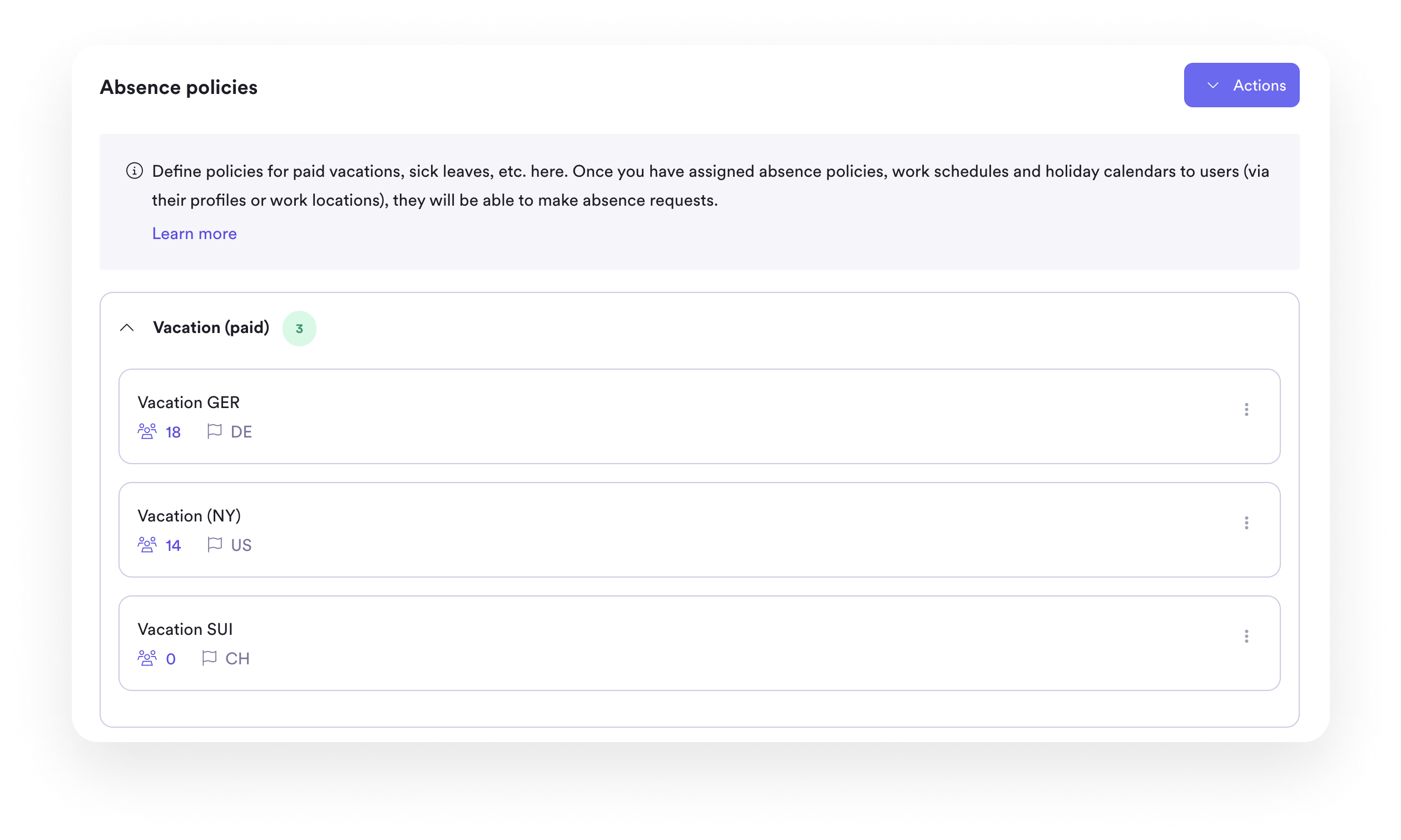Absence management: a comprehensive guide

Absence management isn’t just about tracking who’s in and who’s out — it’s a core part of understanding employee well-being and engagement. For HR professionals, understanding absence patterns, reasons behind leave requests, and the broader cultural implications can inform smarter decisions and foster a more engaged workforce.
When employees hesitate to take time off, it can signal larger issues. For instance, 53% of US professionals didn’t use all their paid time off last year, which may reflect workplace cultures that undervalue rest and recovery.*
Effective absence management can help prevent that. It’s about building clear policies and supportive practices that keep business operations running smoothly while encouraging employees to take the time they need.
This guide will show you why absence management matters in 2025, how to build a strong absence policy, and the best practices to get it right.
💪 Make your absence management workflow seamless
Leapsome’s HRIS helps HR teams centralize data, streamline processes, and say goodbye to manual work.
👉 Explore it now
*Expedia, 2024
What is absence management?
Absence management refers to policies, processes, and workflows organizations use to track and manage employee absences. It includes everything from tracking PTO requests and sick leave to understanding unplanned absences and monitoring trends.
The idea isn’t to prevent employees from taking time off — everyone needs a break. Effective absence management is about minimizing operational disruptions and tracking relevant employee data that could help you spot workplace issues (e.g., an imbalance between days of leave taken and earned time off).
As a core HR practice, effective absence management also aims to streamline processes for managing leave requests and taking measures to reduce absenteeism.
🌟 Check out our comprehensive library of resources to learn more about absenteeism and its impacts and get specific guidance on creating an absence policy.
✨ Read our modern guide to reducing absenteeism for concrete steps to minimize unnecessary absences within your organization.
✨ Check out our article on absenteeism rates for guidance on calculating your company’s absence data.
✨ Our guide to leave management is a helpful resource for HR teams that need help managing employee time off.
✨ Learn how to create an absence policy that aligns with your organization’s culture and needs.
✨ Explore how absence management and PTO-tracking software can help reduce your HR team’s admin workload and make your leave management workflows seamless.
✨ Download our 2024 Workforce Trends Report to understand how employees, leadership, and HR professionals are feeling about the workplace.
Why is absence management important for HR teams in 2025?
Remote and hybrid work are now the norm — 26% of US professionals are fully remote, and 55% work hybrid.* This flexibility requires thoughtful absence management strategies.
At the same time, HR teams must respond to rising workplace stress, political polarization, and incivility. In 2024, 76% of US workers reported witnessing or experiencing workplace incivility, which can contribute to higher absenteeism and lower employee retention.
A solid absence management strategy is indispensable for navigating these challenges, as it can help organizations adapt to these shifts and reduce absenteeism-related business risks.
💡 Technology has kept pace with these changes. Absence management tools like time-tracking software and comprehensive HRIS platforms now allow employees to keep track of their hours and request PTO with limited managerial involvement.
That’s great news for HR leaders thinking about updating their absence management processes for 2025 — and a gentle nudge for teams not yet taking advantage of this technology.
How to create an absence management policy in 5 steps
Follow these steps to design a smooth, people-centered absence management process.

1. Define the who, what & why
Before you start drafting, your HR team and other stakeholders should come together to determine the policy’s purpose and scope. Think of this as the “who, what, and why” behind your absence management policy.
Identify:
- Why you’re establishing the policy (e.g., reduce disruption, support well-being, remain compliant)
- Who the policy applies to, and who will maintain it
- What procedures will govern leave requests, documentation, types of leave, and issues like excessive absence
2. Categorize absences
Once your HR team and other collaborators agree on your absence management policy’s core content, it’s time to qualify each type of absence.
There’s no need to reinvent the wheel here; common types of absences include:
- Planned leave — including PTO, parental leave, paid sabbaticals, and extended medical leave
- Unplanned leave — absences due to illness, bereavement, and other personal emergencies
- Absent without leave (AWOL) — when employees don’t report for work without reason or communication
Remember that certain types of leave, like parental or medical, may be protected by local or federal laws, so make that clear in your policy as well. For example, the Family and Medical Leave Act (FMLA) in the United States entitles employees with qualifying eligibility to up to 12 weeks of unpaid leave for a series of family and medical situations.
As another example, the European Union requires its member states to offer a minimum of four months of parental leave for each parent, with at least two months non-transferable between parents and at least two months paid. Each member state determines specifics, such as the level of payment, and many offer additional leave.
3. Choose an absence management tool

HRIS platforms can help you streamline and automate the administrative aspects of absence management.
For example, Leapsome’s HRIS tool includes an absence management feature that allows HR to set up and run an organized, efficient absence management process. Its straightforward interface is easy for HR team members and employees to use, resulting in less admin work for everyone, fewer errors, and a better overall employee experience.
Absence management tools like Leapsome’s allow People teams to:
- Create, maintain, and assign absence policies for different locations
- Outline processes for managing leave requests
- Define who can access, generate, and edit leave requests
- Approve or deny leave requests with just a few clicks
- View a calendar of pending and approved leave requests
- Choose from predefined lists of leave types (from parental leave to unpaid time off)
- Change system settings to suit company absence guidelines (for example, allowing half days off or requiring a doctor’s note after a certain number of sickness days)
4. Set up request & approval procedures
Managing time off should be simple for employees, managers, and the HR team. That’s why you should choose a user-friendly absence management software solution that can help you reduce repetitive tasks and back-and-forth communications.
For example, you should be able to:
- Create an automated absence request flow
- Ensure that each time off request automatically triggers a notification to the employee’s direct supervisor (and other managers if necessary)
- Enable managers to approve or deny requests with just a couple of clicks (while giving managers space to leave notes if they need to deny)
👏 Simplify absence management
Leapsome helps HR teams create efficient, automated absence management workflows — saving time and supporting every employee.
👉 Learn more about our HRIS
5. Communicate, train & monitor

Share your absence management policy across your usual internal channels — Slack, Microsoft Teams, or your company newsletter. Post it in multiple places employees check regularly, like your employee handbook or HRIS platform.
Before rollout, train all managers and supervisors on how to implement and enforce the policy. And once it’s in full effect, use your absence management platform to monitor employee absences and generate reports to identify patterns and trends.
💡 Keep the feedback loop open for employees with tools like pulse surveys and anonymous suggestion boxes so they can easily share their thoughts and concerns.
Best practices for excellent absence management
Whether you’re refreshing your approach to absence management or creating policies for the first time, these best practices will help you handle employee time off in an efficient, people-centered manner.
Train managers to handle team absences
Ensure your managers get dedicated absence management training. You could leverage an L&D tool like Leapsome Learning to deliver training content with self-paced courses, videos, and quizzes.
Elements of this training might include:
- Scheduling 1:1 check-ins with reports after extended absences
- Adjusting workloads and delegating tasks to account for absences
- Reviewing the company’s absence policy with team members (especially recent joiners)
- Knowing how to identify employees who may be misusing absence policies
- Modeling excellent communication skills and absence practices
Investigate the root cause of absences
While many absences don’t indicate a problem, patterns of unplanned absences can indicate issues like workplace dissatisfaction or even burnout. Managers and HR professionals must look for trends and use employee feedback surveys to uncover underlying causes.
Research has shown that when team member satisfaction decreases, absenteeism increases — and higher job satisfaction results in an average 78% decrease in absenteeism.

Comply with federal & local regulations
Countries and sometimes even (federal) states within the same country have diverse regulations regarding workplace absences and leave entitlements — so researching the laws that apply to your organization is essential.
If your business operates in several countries or has a distributed workforce, you may need to comply with various labor laws. For this reason, we recommend consulting a qualified specialist when developing your absence management policy.
Take care of your people with great absence management

Great absence management isn’t a “nice-to-have” — it’s essential to any company’s internal operations. It’s crucial to regularly refresh your time off policies, as keeping them up-to-date and people-centered can help you unlock new benefits and increase employee satisfaction.
Still, without a platform to help you simplify the HR processes involved in leave management, you risk overwhelming your HR department.
That’s why you need a full-stack HR platform like Leapsome. Leapsome’s built-in HRIS enables People leaders to balance employee enablement and operational efficiency. Through intuitive admin tools and powerful analytics, your business can integrate comprehensive leave management policies into your human resources strategy — all while enjoying the perks of automation.
With Leapsome, you can also access powerful people enablement features to boost employee growth and satisfaction, such as AI-powered engagement surveys, performance reviews, and more.
The result? A simplified tech stack, rich data insights, and happier employees.
🥰 Create people-centered absence policies
Implement leave management that supports organizational success and employee growth.
👉 Book a demo
Disclaimer: This article is for informational purposes only and doesn’t offer legal advice. While we’ve done our best to ensure accuracy and completeness, we can’t guarantee everything is up-to-date or error-free. For tailored advice, we recommend consulting a qualified lawyer or compliance professional.
FAQs about absence management
What is absence management software?
Absence management software allows organizations to track, manage, and approve employee absences. It’s usually part of a more comprehensive HRIS, which also lets you track time, organize and store employee data, tackle performance management, and handle payroll.
Ready to transform
your People operations?
Automate, connect, and simplify all HR processes across the employee lifecycle.
.webp)
.webp)
 Request a demo today
Request a demo today








.jpg)




















